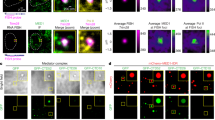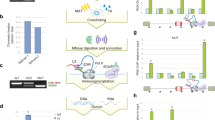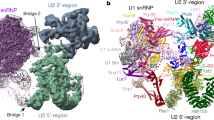Abstract
Coupling between transcription and RNA processing is a key gene regulatory mechanism. Here we use chromatin immunoprecipitation to detect transcription-dependent accumulation of the precursor mRNA (pre-mRNA) splicing factors hnRNP A1, U2AF65 and U1 and U5 snRNPs on the intron-containing human FOS gene. These factors were poorly detected on intronless heat-shock and histone genes, a result that opposes direct recruitment by RNA polymerase II (Pol II) or the cap-binding complex in vivo. However, an observed RNA-dependent interaction between U2AF65 and active forms of Pol II may stabilize U2AF65 binding to intron-containing nascent RNA. We establish chromatin-RNA immunoprecipitation and show that FOS pre-mRNA is cotranscriptionally spliced. Notably, the topoisomerase I inhibitor camptothecin, which stalls elongating Pol II, increased cotranscriptional splicing factor accumulation and splicing in parallel. This provides direct evidence for a kinetic link between transcription, splicing factor recruitment and splicing catalysis.
This is a preview of subscription content, access via your institution
Access options
Subscribe to this journal
Receive 12 print issues and online access
$189.00 per year
only $15.75 per issue
Buy this article
- Purchase on Springer Link
- Instant access to full article PDF
Prices may be subject to local taxes which are calculated during checkout






Similar content being viewed by others
References
Maniatis, T. & Reed, R. An extensive network of coupling among gene expression machines. Nature 416, 499–506 (2002).
Neugebauer, K.M. On the importance of being co-transcriptional. J. Cell Sci. 115, 3865–3871 (2002).
Bentley, D.L. Rules of engagement: co-transcriptional recruitment of pre-mRNA processing factors. Curr. Opin. Cell Biol. 17, 251–256 (2005).
Kornblihtt, A.R. Chromatin, transcript elongation and alternative splicing. Nat. Struct. Mol. Biol. 13, 5–7 (2006).
Cougot, N., van Dijk, E., Babajko, S. & Seraphin, B. 'Cap-tabolism'. Trends Biochem. Sci. 29, 436–444 (2004).
Schroeder, S.C., Schwer, B., Shuman, S. & Bentley, D. Dynamic association of capping enzymes with transcribing RNA polymerase II. Genes Dev. 14, 2435–2440 (2000).
Komarnitsky, P., Cho, E.J. & Buratowski, S. Different phosphorylated forms of RNA polymerase II and associated mRNA processing factors during transcription. Genes Dev. 14, 2452–2460 (2000).
Cheng, C. & Sharp, P.A. RNA polymerase II accumulation in the promoter-proximal region of the dihydrofolate reductase and gamma-actin genes. Mol. Cell. Biol. 23, 1961–1967 (2003).
Kornblihtt, A.R., de la Mata, M., Fededa, J.P., Munoz, M.J. & Nogues, G. Multiple links between transcription and splicing. RNA 10, 1489–1498 (2004).
Jurica, M.S. & Moore, M.J. Pre-mRNA splicing: awash in a sea of proteins. Mol. Cell 12, 5–14 (2003).
Black, D.L. Mechanisms of alternative pre-messenger RNA splicing. Annu. Rev. Biochem. 72, 291–336 (2003).
Kotovic, K.M., Lockshon, D., Boric, L. & Neugebauer, K.M. Cotranscriptional recruitment of the U1 snRNP to intron-containing genes in yeast. Mol. Cell. Biol. 23, 5768–5779 (2003).
Gornemann, J., Kotovic, K.M., Hujer, K. & Neugebauer, K.M. Cotranscriptional spliceosome assembly occurs in a stepwise fashion and requires the cap binding complex. Mol. Cell 19, 53–63 (2005).
Lacadie, S.A. & Rosbash, M. Cotranscriptional spliceosome assembly dynamics and the role of U1 snRNA:5'ss base pairing in yeast. Mol. Cell 19, 65–75 (2005).
Tardiff, D.F. & Rosbash, M. Arrested yeast splicing complexes indicate stepwise snRNP recruitment during in vivo spliceosome assembly. RNA 12, 968–979 (2006).
McCracken, S. et al. The C-terminal domain of RNA polymerase II couples mRNA processing to transcription. Nature 385, 357–361 (1997).
Licatalosi, D.D. et al. Functional interaction of yeast pre-mRNA 3′ end processing factors with RNA polymerase II. Mol. Cell 9, 1101–1111 (2002).
Yih, L.H., Peck, K. & Lee, T.C. Changes in gene expression profiles of human fibroblasts in response to sodium arsenite treatment. Carcinogenesis 23, 867–876 (2002).
Stewart, A.F., Herrera, R.E. & Nordheim, A. Rapid induction of c-fos transcription reveals quantitative linkage of RNA polymerase II and DNA topoisomerase I enzyme activities. Cell 60, 141–149 (1990).
Fivaz, J., Bassi, M.C., Pinaud, S. & Mirkovitch, J. RNA polymerase II promoter-proximal pausing upregulates c-fos gene expression. Gene 255, 185–194 (2000).
Rasmussen, E.B. & Lis, J.T. In vivo transcriptional pausing and cap formation on three Drosophila heat shock genes. Proc. Natl. Acad. Sci. USA 90, 7923–7927 (1993).
Boehm, A.K., Saunders, A., Werner, J. & Lis, J.T. Transcription factor and polymerase recruitment, modification, and movement on dhsp70 in vivo in the minutes following heat shock. Mol. Cell. Biol. 23, 7628–7637 (2003).
Dreyfuss, G., Kim, V.N. & Kataoka, N. Messenger-RNA-binding proteins and the messages they carry. Nat. Rev. Mol. Cell Biol. 3, 195–205 (2002).
Hutchison, S., LeBel, C., Blanchette, M. & Chabot, B. Distinct sets of adjacent heterogeneous nuclear ribonucleoprotein (hnRNP) A1/A2 binding sites control 5′ splice site selection in the hnRNP A1 mRNA precursor. J. Biol. Chem. 277, 29745–29752 (2002).
Zhu, J., Mayeda, A. & Krainer, A.R. Exon identity established through differential antagonism between exonic splicing silencer-bound hnRNP A1 and enhancer-bound SR proteins. Mol. Cell 8, 1351–1361 (2001).
Burd, C.G. & Dreyfuss, G. RNA binding specificity of hnRNP A1: significance of hnRNP A1 high-affinity binding sites in pre-mRNA splicing. EMBO J. 13, 1197–1204 (1994).
Ljungman, M. & Hanawalt, P.C. The anti-cancer drug camptothecin inhibits elongation but stimulates initiation of RNA polymerase II transcription. Carcinogenesis 17, 31–35 (1996).
Collins, I., Weber, A. & Levens, D. Transcriptional consequences of topoisomerase inhibition. Mol. Cell. Biol. 21, 8437–8451 (2001).
Khobta, A. et al. Early effects of topoisomerase I inhibition on RNA polymerase II along transcribed genes in human cells. J. Mol. Biol. 357, 127–138 (2006).
Kroeger, P.E. & Rowe, T.C. Analysis of topoisomerase I and II cleavage sites on the Drosophila actin and Hsp70 heat shock genes. Biochemistry 31, 2492–2501 (1992).
Goldstrohm, A.C., Greenleaf, A.L. & Garcia-Blanco, M.A. Co-transcriptional splicing of pre-messenger RNAs: considerations for the mechanism of alternative splicing. Gene 277, 31–47 (2001).
Robert, F., Blanchette, M., Maes, O., Chabot, B. & Coulombe, B. A human RNA polymerase II-containing complex associated with factors necessary for spliceosome assembly. J. Biol. Chem. 277, 9302–9306 (2002).
Kim, E., Du, L., Bregman, D.B. & Warren, S.L. Splicing factors associate with hyperphosphorylated RNA polymerase II in the absence of pre-mRNA. J. Cell Biol. 136, 19–28 (1997).
Chabot, B., Bisotto, S. & Vincent, M. The nuclear matrix phosphoprotein p255 associates with splicing complexes as part of the [U4/U6.U5] tri-snRNP particle. Nucleic Acids Res. 23, 3206–3213 (1995).
Mortillaro, M.J. et al. A hyperphosphorylated form of the large subunit of RNA polymerase II is associated with splicing complexes and the nuclear matrix. Proc. Natl. Acad. Sci. USA 93, 8253–8257 (1996).
Osheim, Y.N., Miller, O.L., Jr. & Beyer, A.L. RNP particles at splice junction sequences on Drosophila chorion transcripts. Cell 43, 143–151 (1985).
Beyer, A.L. & Osheim, Y.N. Splice site selection, rate of splicing, and alternative splicing on nascent transcripts. Genes Dev. 2, 754–765 (1988).
Wetterberg, I., Bauren, G. & Wieslander, L. The intranuclear site of excision of each intron in Balbiani ring 3 pre-mRNA is influenced by the time remaining to transcription termination and different excision efficiencies for the various introns. RNA 2, 641–651 (1996).
Bauren, G. & Wieslander, L. Splicing of Balbiani ring 1 gene pre-mRNA occurs simultaneously with transcription. Cell 76, 183–192 (1994).
Kiseleva, E., Wurtz, T., Visa, N. & Daneholt, B. Assembly and disassembly of spliceosomes along a specific pre-messenger RNP fiber. EMBO J. 13, 6052–6061 (1994).
Wyatt, J.R., Sontheimer, E.J. & Steitz, J.A. Site-specific cross-linking of mammalian U5 snRNP to the 5′ splice site before the first step of pre-mRNA splicing. Genes Dev. 6, 2542–2553 (1992).
Maroney, P.A., Romfo, C.M. & Nilsen, T.W. Functional recognition of 5′ splice site by U4/U6.U5 tri-snRNP defines a novel ATP-dependent step in early spliceosome assembly. Mol. Cell 6, 317–328 (2000).
Stevens, S.W. et al. Composition and functional characterization of the yeast spliceosomal penta-snRNP. Mol. Cell 9, 31–44 (2002).
Malca, H., Shomron, N. & Ast, G. The U1 snRNP base pairs with the 5′ splice site within a penta-snRNP complex. Mol. Cell. Biol. 23, 3442–3455 (2003).
Ujvari, A. & Luse, D.S. Newly initiated RNA encounters a factor involved in splicing immediately upon emerging from within RNA polymerase II. J. Biol. Chem. 279, 49773–49779 (2004).
Hicks, M.J., Yang, C.R., Kotlajich, M.V. & Hertel, K.J. Linking splicing to Pol II transcription stabilizes pre-mRNAs and influences splicing patterns. PLoS Biol. 4, e147 (2006).
Ghosh, S. & Garcia-Blanco, M.A. Coupled in vitro synthesis and splicing of RNA polymerase II transcripts. RNA 6, 1325–1334 (2000).
Das, R. et al. Functional coupling of RNAP II transcription to spliceosome assembly. Genes Dev. 20, 1100–1109 (2006).
Fong, N. & Bentley, D.L. Capping, splicing, and 3′ processing are independently stimulated by RNA polymerase II: different functions for different segments of the CTD. Genes Dev. 15, 1783–1795 (2001).
Bird, G., Zorio, D.A. & Bentley, D.L. RNA polymerase II carboxy-terminal domain phosphorylation is required for cotranscriptional pre-mRNA splicing and 3′-end formation. Mol. Cell. Biol. 24, 8963–8969 (2004).
Roberts, G.C., Gooding, C., Mak, H.Y., Proudfoot, N.J. & Smith, C.W. Co-transcriptional commitment to alternative splice site selection. Nucleic Acids Res. 26, 5568–5572 (1998).
Howe, K.J., Kane, C.M. & Ares, M., Jr. Perturbation of transcription elongation influences the fidelity of internal exon inclusion in Saccharomyces cerevisiae. RNA 9, 993–1006 (2003).
de la Mata, M. et al. A slow RNA polymerase II affects alternative splicing in vivo. Mol. Cell 12, 525–532 (2003).
Kadener, S. et al. Antagonistic effects of T-Ag and VP16 reveal a role for RNA pol II elongation on alternative splicing. EMBO J. 20, 5759–5768 (2001).
Cramer, P., Pesce, C.G., Baralle, F.E. & Kornblihtt, A.R. Functional association between promoter structure and transcript alternative splicing. Proc. Natl. Acad. Sci. USA 94, 11456–11460 (1997).
Batsche, E., Yaniv, M. & Muchardt, C. The human SWI/SNF subunit Brm is a regulator of alternative splicing. Nat. Struct. Mol. Biol. 13, 22–29 (2006).
Kontermann, R.E. et al. Characterization of the epitope recognized by a monoclonal antibody directed against the largest subunit of Drosophila RNA polymerase II. Biol. Chem. Hoppe Seyler 376, 473–481 (1995).
Gama-Carvalho, M. et al. Targeting of U2AF65 to sites of active splicing in the nucleus. J. Cell Biol. 137, 975–987 (1997).
Kuo, M.H. & Allis, C.D. In vivo cross-linking and immunoprecipitation for studying dynamic protein:DNA associations in a chromatin environment. Methods 19, 425–433 (1999).
Chakrabarti, S.K., James, J.C. & Mirmira, R.G. Quantitative assessment of gene targeting in vitro and in vivo by the pancreatic transcription factor, Pdx1. Importance of chromatin structure in directing promoter binding. J. Biol. Chem. 277, 13286–13293 (2002).
Acknowledgements
Special thanks to F. Stewart for his suggestions regarding FOS induction and the use of camptothecin. We are grateful to D. Black, M. Rosbash, C. Eckmann, T. Langenberg, D. Stanek and members of our laboratory for helpful discussions and comments on the manuscript. This research was funded by support from the Max Planck Gesellschaft.
Author information
Authors and Affiliations
Contributions
K.M.N. and I.L. conceived and designed the experiments. I.L. and A.K.S. performed the experiments. I.L. analyzed the data. K.M.N. wrote the paper.
Corresponding author
Ethics declarations
Competing interests
The authors declare no competing financial interests.
Supplementary information
Supplementary Fig. 1
Sodium arsenite treatment does not alter the nuclear localization of U1-70K, U2AF65 and snRNAs. (PDF 110 kb)
Supplementary Fig. 2
Distribution of acetylated histone H4 along the induced FOS gene with and without camptothecin. (PDF 88 kb)
Supplementary Fig. 3
Characterization of the ChRIP assay. (PDF 257 kb)
Rights and permissions
About this article
Cite this article
Listerman, I., Sapra, A. & Neugebauer, K. Cotranscriptional coupling of splicing factor recruitment and precursor messenger RNA splicing in mammalian cells. Nat Struct Mol Biol 13, 815–822 (2006). https://doi.org/10.1038/nsmb1135
Received:
Accepted:
Published:
Issue Date:
DOI: https://doi.org/10.1038/nsmb1135
This article is cited by
-
Temporal-iCLIP captures co-transcriptional RNA-protein interactions
Nature Communications (2023)
-
Elongation roadblocks mediated by dCas9 across human genes modulate transcription and nascent RNA processing
Nature Structural & Molecular Biology (2023)
-
Combining genetic constraint with predictions of alternative splicing to prioritize deleterious splicing in rare disease studies
BMC Bioinformatics (2022)
-
RETRACTED ARTICLE: AKT3-mediated IWS1 phosphorylation promotes the proliferation of EGFR-mutant lung adenocarcinomas through cell cycle-regulated U2AF2 RNA splicing
Nature Communications (2021)
-
Identification of genes underlying phenotypic plasticity of wing size via insulin signaling pathway by network-based analysis in Sogatella furcifera
BMC Genomics (2019)



